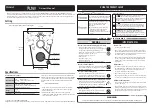
Lake Shore Model 460 Gaussmeter User’s Manual
3-2
Operation
Front Panel Keypad Definitions (Continued)
Zero Probe
Used to zero or null effects of ambient low level fields from the probe. This function
is not available for Vector Magnitude. Refer to Paragraph 3.3.
Select Range
Push to manually select the field measurement range. Available ranges are
dependent on which probe is installed. This function is not available for Vector
Magnitude. Refer to Paragraph 3.4.
Auto Range
Turns the Auto Range feature on and off. Allows the Model 460 to automatically
select the field measurement range. This function is not available for Vector
Magnitude. Refer to Paragraph 3.4.
AC/DC
Selects periodic (AC) or static (DC) magnetic fields. The AC selection provides the
user with the choice of Peak or RMS readings. This function is not available for
Vector Magnitude. Refer to Paragraph 3.5.
Peak/RMS
The AC selection provides the user with the choice of Peak or Root Mean Square
(RMS) readings. AC peak can also be used with the Max Hold feature to measure
single pulse peak values. This function is not available for Vector Magnitude. Refer
to Paragraph 3.5.
Filter
Turns the filter on or off and allows configuration of filter. Filter on enables high
resolution DC readings. Press and hold Filter key to select Field Compensation and
Temperature Compensation on or off. This function is not available for Vector
Magnitude. Refer to Paragraph 3.6.
Gauss/Tesla
Changes display units from gauss to tesla. Gauss (G) is used in the cgs system,
where 1 G = 10
–4
T. Tesla (T) is used in the SI system, where 1 T = 10
4
G. This is a
global setting (applies to all channels). Refer to Paragraph 3.8.
Relative Set
With the relative feature turned on, this key is used to capture the present field
reading as the relative setpoint. You also have the option of entering a number via
the numerical keypad. Works with the Relative On/Off key. Refer to Paragraph 3.9.
Relative On/Off
Turns on the relative feature which displays the positive or negative deviation from
the relative setpoint. The relative feature can also be used with the Max Hold and
Alarm features. Refer to Paragraph 3.9.
Alarm Set
This key is used to set the high and low alarm points. The alarm setpoints are
absolute (unsigned) i.e., the positive or negative aspect of the field reading is
ignored. Refer to Paragraph 3.10.
Alarm On/Off
Turns the alarm feature on or off. Press and hold the Alarm On/Off key to turn the
audible alarm on or off and select the alarm to activate inside or outside the range.
Refer to Paragraph 3.10.
Local
This key is used to select local or remote operation. When set to Local, the unit
responds to front panel controls. When set to Remote, the unit is controlled via the
IEEE-488 Interface. Refer to Paragraph 3.11.
Interface
Sets the bus address and terminators for the IEEE-488 Interface and Baud rate for
the Serial Interface. Refer to Paragraph 3.11.
Display
Use this key to set the display brightness. Refer to Paragraph 3.12.
Analog Out
Used to set the source and scaling of the Corrected Analog Output. The scaling of
the three Monitor Analog Outputs cannot be modified. Refer to Paragraph 3.13.
Summary of Contents for 460
Page 4: ......
Page 7: ...Lake Shore Model 460 Gaussmeter User s Manual ...
Page 8: ......
Page 108: ......
















































